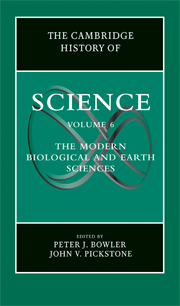Book contents
- Frontmatter
- 1 Introduction
- PART I WORKERS AND PLACES
- PART II ANALYSIS AND EXPERIMENTATION
- 10 Geology
- 11 Paleontology
- 12 Zoology
- 13 Botany
- 14 Evolution
- 15 Anatomy, Histology, and Cytology
- 16 Embryology
- 17 Microbiology
- 18 Physiology
- 19 Pathology
- PART III NEW OBJECTS AND IDEAS
- PART IV SCIENCE AND CULTURE
- Index
- References
16 - Embryology
from PART II - ANALYSIS AND EXPERIMENTATION
Published online by Cambridge University Press: 28 November 2009
- Frontmatter
- 1 Introduction
- PART I WORKERS AND PLACES
- PART II ANALYSIS AND EXPERIMENTATION
- 10 Geology
- 11 Paleontology
- 12 Zoology
- 13 Botany
- 14 Evolution
- 15 Anatomy, Histology, and Cytology
- 16 Embryology
- 17 Microbiology
- 18 Physiology
- 19 Pathology
- PART III NEW OBJECTS AND IDEAS
- PART IV SCIENCE AND CULTURE
- Index
- References
Summary
“If … we say that each human individual develops from an egg, the only answer, even of most so-called educated men, will be an incredulous smile; if we show them the series of embryonic forms developed from this human egg, their doubt will, as a rule, change into disgust. Few … have any suspicion,” wrote evangelist of evolution Ernst Haeckel in the 1870s, “that these human embryos conceal a greater wealth of important truths, and form a more abundant source of knowledge than is afforded by the whole mass of most other sciences and of all so-called ‘revelations.’” Between this extravagant claim and the incredulity and disgust that it invokes lies a contradictory history. In nineteenth-century universities and medical schools embryology was a key science of life; around 1900 modern biology was forged within it; and as developmental biology it buzzes with excitement today. Embryology fired wide publics with Darwinist fervor, sexual knowledge, and the prospect of reproductive control; but it also bored generations of medical students, was molecular biologists’ favorite example of scientific decline, and has attracted both feminist and antiabortionist critiques. There are, then, rich histories to be told, and as scholars in various disciplines begin to tell them, existing surveys have come to seem thin. Largely confined to concepts and theories, they tell us little about the daily life of embryology. Written within particular traditions, they do scant justice to the diversity of embryo science and the variety of perspectives on it.
- Type
- Chapter
- Information
- The Cambridge History of Science , pp. 285 - 315Publisher: Cambridge University PressPrint publication year: 2009
References
- 21
- Cited by



